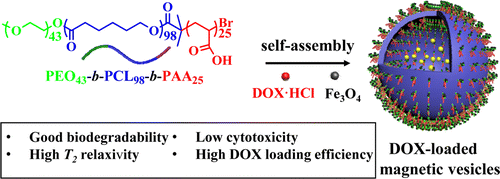Rationally Separating the Corona and Membrane Functions of Polymer Vesicles for Enhanced T2 MRI and Drug Delivery
作者:Jingya Qin, Qiuming Liu, Junxue Zhang, Jing Chen, Shuai Chen, Yao Zhao, Jianzhong Du* 时间:2015-06-05 点击数:

Abstract
It is an important challenge to in situ grow ultrafine super-paramagnetic iron oxide nanoparticles (SPIONs) in drug carriers such as polymer vesicles (also called polymersomes) while keeping their biodegradability for enhanced T2-weighted magnetic resonance imaging (MRI) and drug delivery. Herein, we present a new strategy by rationally separating the corona and membrane functions of polymer vesicles to solve the above problem. We designed a poly(ethylene oxide)-block-poly(ε-caprolactone)-block-poly(acrylic acid) (PEO43-b-PCL98-b-PAA25) triblock copolymer and self-assembled it into polymer vesicle. The PAA chains in the vesicle coronas are responsible for the in situ nanoprecipitation of ultrafine SPIONs, while the vesicle membrane composed of PCL is biodegradable. The SPIONs-decorated vesicle is water-dispersible, biocompatible, and slightly cytotoxic to normal human cells. Dynamic light scattering, transmission electron microscopy, energy disperse spectroscopy, and vibrating sample magnetometer revealed the formation of ultrafine super-paramagnetic Fe3O4 nanoparticles (1.9 ± 0.3 nm) in the coronas of polymer vesicles. Furthermore, the CCK-8 assay revealed low cytotoxicity of vesicles against normal L02 liver cells without and with Fe3O4 nanoparticles. The in vitro and in vivo MRI experiments confirmed the enhanced T2-weighted MRI sensitivity and excellent metastasis in mice. The loading and release experiments of an anticancer drug, doxorubicin hydrochloride (DOX·HCl), indicated that the Fe3O4-decorated magnetic vesicles have potential applications as a nanocarrier for anticancer drug delivery. Moreover, the polymer vesicle is degradable in the presence of enzyme such as Pseudomonas lipases, and the ultrafine Fe3O4 nanoparticles in the vesicle coronas are confirmed to be degradable under weakly acidic conditions. Overall, this decoration-in-vesicle-coronas strategy provides us with a new insight for preparing water-dispersible ultrafine super-paramagnetic Fe3O4 nanoparticles with promising theranostic applications in biomedicine.
文章链接:ACS Applied Materials & Interfaces 2015, 7, 14043–14052.